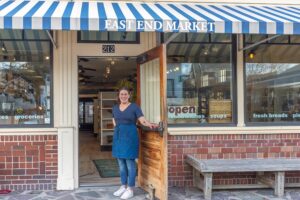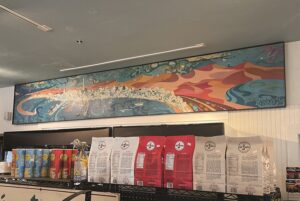PROVINCETOWN — Outer Cape native Oriana Conklin opened the doors to her newly purchased East End Market at 212 Bradford St. on March 11, 2022.
Exactly one year later, on March 11, 2023, she opened them again.

They had been closed for 10 weeks after a powerful storm on Dec. 23 sent salt water coursing over Commercial Street, down Howland Street, and into her store, soaking the kitchen and destroying electrical equipment.
Conklin didn’t realize that March 11 was an anniversary until her sister pointed it out. She’s been distracted by the $300,000 of damage wrought by the two feet of water that rose through her floorboards that day.
“It was bound to happen,” she said. “I just didn’t think it would happen this quickly.”
Officially, 212 Bradford is in a 100-year flood zone. The building has housed a neighborhood market since 1949, when it was called the Patrician Shop and sold famously delicious Portuguese soup. According to FEMA, the property has never flooded, although two neighbors remember a saltwater flood occurring here in 1978, Conklin said.
Conklin sits on the Provincetown Conservation Commission and joined the newly convened Coastal Resiliency Advisory Committee in January. She is both studying the problem and experiencing it.
“I feel like I can bring hands-on experience,” she said. “A lot of it is numbers and science, but there’s so much you can learn from stories and actual people that dealt with it that day.”
Dec. 23 was harrowing. The shop flooded from below, with salt water filling the crawl space beneath and rising through the floorboards all at once. Sandbagging the doors would have made little difference, Conklin said.
At around 11 a.m., the fire dept. ordered Conklin and her team to evacuate because of the flooded electrical systems. No one could return until 3 p.m., when the water finally receded through storm drains. With the power still off, about 20 people from the neighborhood arrived with headlamps and helped move salvageable inventory upstairs. That work continued for the next two days until the power returned on Boxing Day, three days after the storm.
“Christmas didn’t really happen,” Conklin said.
The market lost about $70,000 in food and dry goods; the other $230,000 was damage to the floors, the walls, and the market’s 14 refrigerators. “You don’t think that two feet of water can do that,” Conklin said. But corrosive salt water and septic spillover was a potent mix.

The building had old-school fluffy pink insulation, which grew mold; it’s been replaced with spray foam. The new floorboards are waterproof, or at least are supposed to be. Four of the fridges were saved by replacing the motors, although that’s a temporary fix.
“We’re trying to make little improvements in case it happens again, because I think it will,” Conklin said.
To weather the financial storm, Conklin maxed out her credit cards and relied on her many connections in town. Local contractors have fronted their services, knowing Conklin is expecting an insurance check. Seamen’s Bank, which holds one of the market’s loans (the Small Business Association holds the other), has been “amazing and so helpful,” Conklin said.
And with assistance from an online fundraiser started by Miranda Trussell, a friend of former kitchen manager Ian Schillinger, Conklin was able to pay her employees for all but two weeks’ worth of wages lost during the repairs. (Schillinger has since left East End Market to start his own business at the Aquarium Mall, which is opening in April.)
“The neighborhood’s been really very supportive,” said Conklin. “Otherwise I would’ve lost my mind.”
Insurance has been “a complete nightmare,” she added. She has yet to see an insurance agent at the market; she received her first payment 84 days after filing a claim.
On a recent Friday, artist Mark Adams stopped in. “It’s fantastic to come down here because they have unique things that other places don’t have, but also because I love the staff,” he said.
Adams is also on the coastal resiliency committee with Conklin. As storm force increases and sea levels rise, he said, “We have to have all the tools at hand, because this town’s not going to go away.”
East End resident Marc Guerrette was part of the ad hoc team that pitched in on the day of the flood. The market is a cherished resource, he said, because residents can walk over and get what they need from a small business rather than making a trip to Stop & Shop. “It’s the local gathering spot,” he said. “The true nature of a small town is when things like this happen people just drop what they’re doing to go help out. That’s what community is.”
Considering the scope of the damage, the market bounced back quickly, returning to operations as soon of the board of health gave the okay.
Conklin used the weeks of displacement to make a few changes. The coffee station has been moved up to the front of the store. “We needed a central area where people can come in and talk,” she said.
And with shorter shelf units, customers now have a clear sight line to the Harvey Dodd mural that has graced the back wall since 1968. At the time, Dodd was living two doors down and traded the painting for groceries. “But then he got really popular, and that’s why it’s not finished,” Conklin said.
In past iterations, the market sold all kinds of goods, from bait and tackle to pornography, Adams and Conklin said. They swapped ideas over coffee. “We should bring back guitar strings — and they had really good banana splits, so maybe that,” Conklin said. “Guitar strings and banana splits.”



